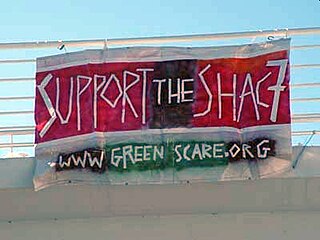
People for the Ethical Treatment of Animals is an American animal rights nonprofit organization based in Norfolk, Virginia, and led by Ingrid Newkirk, its international president. PETA says that its entities have more than 9 million members globally.
The Revolutionary Cells – Animal Liberation Brigade (RCALB), known simply as Animal Liberation Brigade (ALB), is a name used by animal liberationists who advocate the use of freedom and a diversity of tactics within the animal liberation movement, whether non-violent or not. As part of a praxis, the intention is to destroy oppressive institutions, describing an endgame for animal abusers.

Huntingdon Life Sciences (HLS) was a contract research organisation (CRO) founded in 1951 in Cambridgeshire, England. It had two laboratories in the United Kingdom and one in the United States. With over 1,600 staff, it was until 2015 the largest non-clinical CRO in Europe. In September 2015, Huntingdon Life Sciences, Harlan Laboratories, GFA, NDA Analytics and LSR associates merged into Envigo, which later sold off the CRO part.
Keith Mann is a British animal rights campaigner and direct action activist who acted as a spokesman for the Animal Liberation Front (ALF), and was alleged by police in 2005 to be a ringleader for the ALF. He was imprisoned twice, and is the author of From Dusk 'til Dawn: An Insider's View of the Growth of the Animal Liberation Movement (2007).
Leaderless resistance, or phantom cell structure, is a social resistance strategy in which small, independent groups, or individuals, challenge an established institution such as a law, economic system, social order, or government. Leaderless resistance can encompass anything from non-violent protest and civil disobedience to vandalism, terrorism, and other violent activity.
The Animal Rights Militia (ARM) is a banner used by animal rights activists who engage in direct action utilizing a diversity of tactics that ignores the Animal Liberation Front's policy of taking all necessary precautions to avoid harm to human life.
The Justice Department (JD) was founded in the United Kingdom by animal rights activists who declared they were willing to use a diversity of tactics up to and including violence against their opponents. Initially calling for "abusers to have but a taste of the fear and anguish their victims suffer on a daily basis", activists established a separate idea from adhering to the Animal Liberation Front's (ALF) guidelines of non-violent resistance, similar to that of the Animal Rights Militia (ARM).
Greg Avery is a British animal rights activist. His latest involvement is with Stop Huntingdon Animal Cruelty (SHAC), an international campaign to force the closure of Huntingdon Life Sciences (HLS), an animal testing company based in the UK and US.

The animal rights (AR) movement, sometimes called the animal liberation, animal personhood, or animal advocacy movement, is a social movement that seeks an end to the rigid moral and legal distinction drawn between human and non-human animals, an end to the status of animals as property, and an end to their use in the research, food, clothing, and entertainment industries.
SPEAK is a British animal rights group working to end animal testing in the UK.
Ronnie Lee is a British animal rights activist. He is known primarily for being the Press Officer for the UK Animal Liberation Front (ALF) in 1976. He also founded the magazine Arkangel in 1989.

The Green Scare is legal action by the US government against the radical environmental movement, that occurred mostly in the 2000s. It alludes to the Red Scares, periods of fear over communist infiltration of US society.
Shannon Keith is an American animal rights lawyer, activist, and documentary director/producer. She is the director of the Animal Liberation Front documentary, Behind the Mask: The Story Of The People Who Risk Everything To Save Animals.
This timeline of Animal Liberation Front (ALF) actions describes the history, consequences and theory of direct action on behalf of animals by animal liberation activists using, or associated with the ALF.
The Western Animal Rights Network (WARN) first appeared in 2005 as a coalition for animal rights groups in the West of England and South Wales and acted as a news service for animal rights demos and action reports.

The Animal Liberation Front (ALF) is an international, leaderless, decentralized political and social resistance movement that advocates and engages in what it calls non-violent direct action in protest against incidents of animal cruelty. It originated in Britain in the 1970s from the Bands of Mercy. Participants state it is a modern-day Underground Railroad, removing animals from laboratories and farms, destroying facilities, arranging safe houses, veterinary care and operating sanctuaries where the animals subsequently live. Critics have labelled them as eco-terrorists.
Heather Nicholson is a British animal rights activist.

Daniel Andreas San Diego is an American domestic terrorism suspect who is listed on the FBI Most Wanted Terrorists list. He is a straight edge vegan environmentalist and animal liberationist believed to have ties to an Animal Liberation Brigade cell responsible for two bombings in 2003. Andreas is also believed to have ties to Stop Huntingdon Animal Cruelty.
The campaign against Highgate Rabbit Farm, also known as the Close Highgate Farm campaign, is a series of direct actions by anti-vivisection activists. Highgate Rabbit Farm in Market Rasen, Lincolnshire in England is licensed by the Home Office to breed rabbits and ferrets for animal-testing facilities, including Huntingdon Life Sciences. Actions have included a raid by the Animal Liberation Front (ALF) and an arson claimed by the Militant Forces Against HLS. The ALF raid in 2008 saw 129 rabbits removed and £100,000-worth of damage to property. The campaign has been linked to activists involved in Stop Huntingdon Animal Cruelty (SHAC).

Jake Conroy is an American animal rights activist and vegan who was involved with Stop Huntingdon Animal Cruelty (SHAC), an international campaign to force the closure of Huntingdon Life Sciences (HLS), an animal-testing company based in the UK and US, for which he designed and maintained the SHAC websites. Conroy had previously been a co-founder and activist for an anti-whaling group Ocean Defense International, formally called Sea Defence Alliance, and director of Northwest Animal Rights Network.









